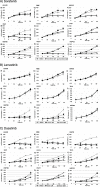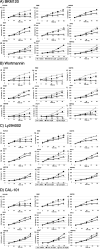Differential in vitro effects of targeted therapeutics in primary human liver cancer: importance for combined liver cancer
- PMID: 36402986
- PMCID: PMC9675209
- DOI: 10.1186/s12885-022-10247-6
Differential in vitro effects of targeted therapeutics in primary human liver cancer: importance for combined liver cancer
Abstract
The incidence of primary liver tumors, hepatocellular carcinoma (HCC), intrahepatic cholangiocellular carcinoma (ICC), and combined HCC/ICC (cHCC/CC) is increasing. For ICC, targeted therapy exists only for a small subpopulation of patients, while for HCC, Sorafenib and Lenvatinib are in use. Diagnosis of cHCC/CC is a great challenge and its incidence is underestimated, bearing the risk of unintended non-treatment of ICC. Here, we investigated effects of targeted inhibitors on human ICC cell lines (HUH28, RBE, SSP25), in comparison to extrahepatic (E)CC lines (EGI1, CCC5, TFK1), and HCC/hepatoblastoma cell lines (HEP3B, HUH7, HEPG2). Cells were challenged with: AKT inhibitor MK-2206; multikinase inhibitors Sorafenib, Lenvatinib and Dasatinib; PI3-kinase inhibitors BKM-120, Wortmannin, LY294002, and CAL-101; and mTOR inhibitor Rapamycin. Dosage of the substances was based on the large number of published data of recent years. Proliferation was analyzed daily for four days. All cell lines were highly responsive to MK-2206. Thereby, MK-2206 reduced expression of phospho(p)-AKT in all ICC, ECC, and HCC lines, which mostly corresponded to reduction of p-mTOR, whereas p-ERK1/2 was upregulated in many cases. Lenvatinib showed inhibitory effects on the two HCC cell lines, but not on HEPG2, ICCs and ECCs. Sorafenib inhibited proliferation of all cells, except the ECC line CCC5. However, at reduced dosage, we observed increased cell numbers in some ICC experiments. Dasatinib was highly effective especially in ICC cell lines. Inhibitory effects were observed with all four PI3-kinase inhibitors. However, cell type-specific differences were also evident here. Rapamycin was most effective in the two HCC cell lines. Our studies show that the nine inhibitors differentially target ICC, ECC, and HCC/hepatoblastoma lines. Caution should be taken with Lenvatinib and Sorafenib administration in patients with cHCC/CC as the drugs may have no effects on, or might even stimulate, ICC.
Keywords: AKT pathway; Cholangiocellular carcinoma; Combined liver cancer; Hepatocellular carcinoma; Kinase inhibitors.
© 2022. The Author(s).
Conflict of interest statement
The authors declare that no actual or potential conflict-of-interest in relation to this article exists.
Figures






Similar articles
-
The clinical characteristics and prognostic factors of combined Hepatocellular Carcinoma and Cholangiocarcinoma, Hepatocellular Carcinoma and Intrahepatic Cholangiocarcinoma after Surgical Resection: A propensity score matching analysis.Int J Med Sci. 2021 Jan 1;18(1):187-198. doi: 10.7150/ijms.50883. eCollection 2021. Int J Med Sci. 2021. PMID: 33390787 Free PMC article.
-
Activation of the Akt/mammalian target of rapamycin pathway in combined hepatocellular carcinoma and cholangiocarcinoma: significant correlation between p-4E-BP1 expression in cholangiocarcinoma component and prognosis.Virchows Arch. 2020 Jun;476(6):881-890. doi: 10.1007/s00428-019-02741-3. Epub 2020 Jan 11. Virchows Arch. 2020. PMID: 31927624
-
Combined hepatocellular carcinoma and cholangiocarcinoma: clinical features, treatment modalities, and prognosis.Ann Surg Oncol. 2012 Sep;19(9):2869-76. doi: 10.1245/s10434-012-2328-0. Epub 2012 Mar 27. Ann Surg Oncol. 2012. PMID: 22451237
-
Combined hepatocellular-cholangiocarcinoma: from genesis to molecular pathways and therapeutic strategies.J Cancer Res Clin Oncol. 2024 May 23;150(5):270. doi: 10.1007/s00432-024-05781-8. J Cancer Res Clin Oncol. 2024. PMID: 38780656 Free PMC article. Review.
-
Intrahepatic cholangiocarcinoma: new insights in pathology.Semin Liver Dis. 2011 Feb;31(1):49-60. doi: 10.1055/s-0031-1272839. Epub 2011 Feb 22. Semin Liver Dis. 2011. PMID: 21344350 Review.
Cited by
-
Lenvatinib resistance mechanism and potential ways to conquer.Front Pharmacol. 2023 Apr 20;14:1153991. doi: 10.3389/fphar.2023.1153991. eCollection 2023. Front Pharmacol. 2023. PMID: 37153782 Free PMC article. Review.
-
Dual Inhibition of PI3 Kinase and MAP Kinase Signaling Pathways in Intrahepatic Cholangiocellular Carcinoma Cell Lines Leads to Proliferation Arrest but Not Apoptosis.Curr Issues Mol Biol. 2024 Jul 13;46(7):7395-7410. doi: 10.3390/cimb46070439. Curr Issues Mol Biol. 2024. PMID: 39057080 Free PMC article.
-
Plasma Bile Acid Profiling and Modulation of Secreted Mucin 5AC in Cholangiocarcinoma.Int J Mol Sci. 2023 Aug 14;24(16):12794. doi: 10.3390/ijms241612794. Int J Mol Sci. 2023. PMID: 37628976 Free PMC article.
-
Liver Organoids as an In Vitro Model to Study Primary Liver Cancer.Int J Mol Sci. 2023 Feb 25;24(5):4529. doi: 10.3390/ijms24054529. Int J Mol Sci. 2023. PMID: 36901961 Free PMC article. Review.
-
Licochalcone A Induces Ferroptosis in Hepatocellular Carcinoma via Reactive Oxygen Species Activated by the SLC7A11/GPX4 Pathway.Integr Cancer Ther. 2023 Jan-Dec;22:15347354231210867. doi: 10.1177/15347354231210867. Integr Cancer Ther. 2023. PMID: 37965730 Free PMC article.
References
-
- Adeva J, Sangro B, Salati M, Edeline J, La Casta A, Bittoni A, et al. Medical treatment for cholangiocarcinoma. Liver Int Off J Int Assoc Study Liver. 2019;39(Suppl 1):123–142. - PubMed
-
- Forner A, Vidili G, Rengo M, Bujanda L, Ponz-Sarvisé M, Lamarca A. Clinical presentation, diagnosis and staging of cholangiocarcinoma. Liver Int Off J Int Assoc Study Liver. 2019;39(Suppl 1):98–107. - PubMed
-
- American Cancer Society . Liver Cancer Survival Rates. 2019.
MeSH terms
Substances
LinkOut - more resources
Full Text Sources
Medical
Miscellaneous

